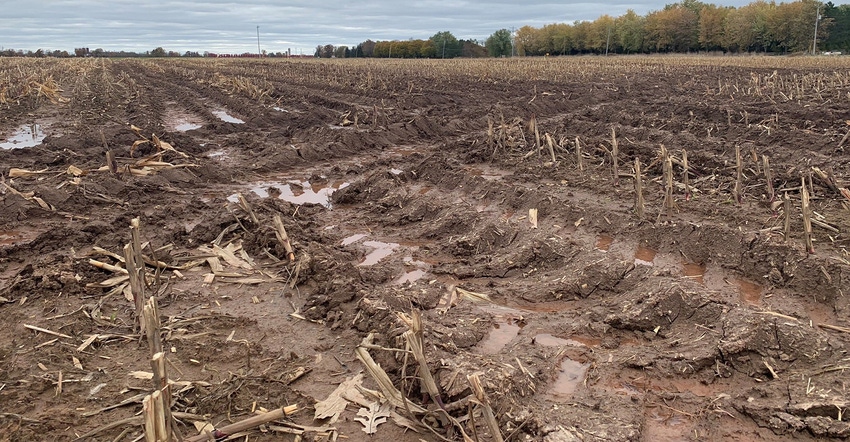February 5, 2020

As you make plans for the 2020 growing season, be sure to assess the damages caused by 2019’s excessively wet growing season and harvest. Looking out over the fields, one likely sees substantial rutting with water standing in the ruts. Several questions come to mind: How much compaction has occurred and to what extent is the damage? What should you do to reduce the effects of compaction on 2020 crop yields?
First, let’s consider how soil compaction affects crop growth and development. Research in Wisconsin and other states has found yield reductions ranging from 10% to 50% due to soil compaction. Reductions occur as a result of several factors, including stunted roots leading to decreased nutrient uptake, increased nitrogen losses due to denitrification and reduced aeration leading to lower soil biological activity. To add insult to injury, more horsepower, and thus more fuel, are required to till compacted soils.
How much compaction has occurred? Answering this question is the first step in planning your response. As you ponder this question, keep in mind that rutting may not mean deep tilling or subsoiling is needed. Surface tillage alone may be sufficient to reduce the compaction, and that compaction repair can take multiple growing seasons.
There are several methods one can use to determine the extent of compaction that has occurred. A simple method is to drive a steel rod into the soil on a fencerow or other area that hasn’t seen wheel traffic and note the effort it takes to drive the stake down 18 inches by counting the hammer strikes. Repeat this process in several areas across the field where soil compaction is suspected. Note whether or not the initial 10 to 12 inches are difficult, indicating surface compaction, and if from 12 to 18 inches is difficult, indicating subsoil compaction.
Another method is to use a cone penetrometer in a similar fashion as the steel rod. Cone penetrometers have an indicator gauge that provides a reading of pounds per square inch of force required to penetrate the soil, a T-handle and a steel rod with a cone on the end. Root growth decreases as penetration resistance increases. Generally, a value of 300 psi or greater indicates soil is compacted enough to stop root growth. View the YouTube video “Using a Penetrometer to Detect Soil Compaction” below. Check with your local Extension office for possible availability of a penetrometer for loan.
Minimizing effects of compaction
For surface compaction, if ruts are present, light tillage may be all that is necessary to prepare for planting, and for no-till, localized tillage to fill ruts may be all the is needed. Freeze and thaw conditions may have alleviated some of the shallow compaction for you. Keep in mind that freezing and thawing will not remove subsoil compaction.
If compaction is detected deeper than 6 to 7 inches, you may need to consider subsoiling. Subsoiling is expensive, and a substantial return in crop yield will be needed to justify it. If you choose to do subsoiling, don’t go when it is too wet. Till only to a depth just below the compacted zone. Deeper tillage only increases risk of even deeper compaction and requires more fuel.
Straight-shanked tools do not invert soil so are better adapted to conservation-tillage systems, and in the absence of ruts may not require a secondary tillage pass. Studies on silty clay loam soils in eastern Wisconsin found that a straight-shanked tool, with the same row spacing as the planter, performed better than an aggressive tool equipped with parabolic shanks and wings.
To prevent compaction going forward:
Wait as long as possible for drier conditions before planting and harvesting.
Keep axle loads below 10 tons, and consider carrying reduced loads when conditions are less than ideal.
Decrease contact pressure by using flotation tires, duals or tracks.
Maintain tires at the manufacturer’s recommended pressures.
Use managed or controlled traffic to reduce area of the field affected by wheel traffic compaction.
Consider no-till and cover crops to build resilience to soil compaction.
For more information, check out Managing Soil Compaction at Planting and Harvest (A4158) and Soil Compaction: Causes, Concerns, and Cures (A3367) at the Extension Learning Store.
Schroeder is the Extension agriculture agent in Portage County, Wis.
About the Author(s)
You May Also Like




